How to Navigate the Duncansby Stacks Walk Without a Tour
15 min readNestled in the most northern extremities of the Scottish Highlands is a realm of untamed landscapes, wild seas, and boundless vistas. This ancient territory, rich in mystery and abundant in treasures, awaits the intrepid explorer. Amidst these wonders stand the formidable Duncansby Sea Stacks, offering breathtaking views – where a coastal walk is an unmissable highlight of any journey along the North Coast 500.
The post How to Navigate the Duncansby Stacks Walk Without a Tour appeared first on Timeless Travel Steps.
If you’re searching for insights on how to independently navigate the Duncansby Stacks Walk in Scotland, you’ve come to the right place. Like many, I was drawn to the allure of these iconic sea stacks, eager to explore them without the constraints of a guided tour.
Amazed is an understatement when describing my experience. From the moment I began my self-guided walk, the raw beauty of Scotland’s rugged coastline unfolded in a dramatic display. The wind, robust and invigorating, carried the fresh scent of the sea, intertwining with the earthy aroma of the surrounding grasslands, enhancing the sense of awe and tranquil solitude. You just need to hang on to your beanie and camera!
The Duncansby Stacks Walk while relatively short at about 2.5 kilometers round-trip is an easy, enjoyable trek along the cliffs. The main attraction being the spectacular views of the stacks from above, rather than a route down to the stacks themselves. This allows visitors to appreciate their grandeur from a safe and scenic vantage point.
I’ll share essential tips and personal insights to help you make the most of your journey. From preparing for the walk and reaching the starting point, to highlighting the must-see spots and navigating the path, this guide covers all you need to confidently embark on this memorable adventure. Whether you’re a seasoned hiker or a casual walker, the Duncansby Stacks Walk offers a unique experience that’s best enjoyed at your own pace, filled with awe-inspiring views of the rugged Caithness coastline.
Timeless Travel Steps is supported by our readers. If you purchase through an affiliate link on my site, at no cost to you, I may earn a commission from qualifying purchases. Please read our Disclosure.

About Duncansby Sea Stacks: What are the Stacks of Duncansby
Nestled in the most northern extremities of the Scottish Highlands is a realm of untamed landscapes, wild seas, and boundless vistas. This ancient territory, rich in mystery and abundant in treasures, awaits the intrepid explorer. Amidst these wonders stand the formidable Duncansby Sea Stacks, offering breathtaking views – where a coastal walk is an unmissable highlight of any journey along the North Coast 500.
The Duncansby Stacks are one of Scotland’s most remarkable geological formations, located near Duncansby Head, just a short distance from John o’ Groats in the Caithness region.
The majestic Duncansby Stacks, a hallmark of the Scottish Highlands, are primarily composed of Old Red Sandstone, a geological signature of the region. These striking formations date back to the Devonian period, around 400 to 415 million years ago.
However, these impressive towering sea rock structures as they are seen today, are believed to have stood there for over the last 6,000 years or so—a blink of an eye in geological terms. Yet a significant period for the transformation of the landscape, formed through the relentless action of the wind and sea that has eroded the cliffs, along the most north eastern point of Scottish coastline.
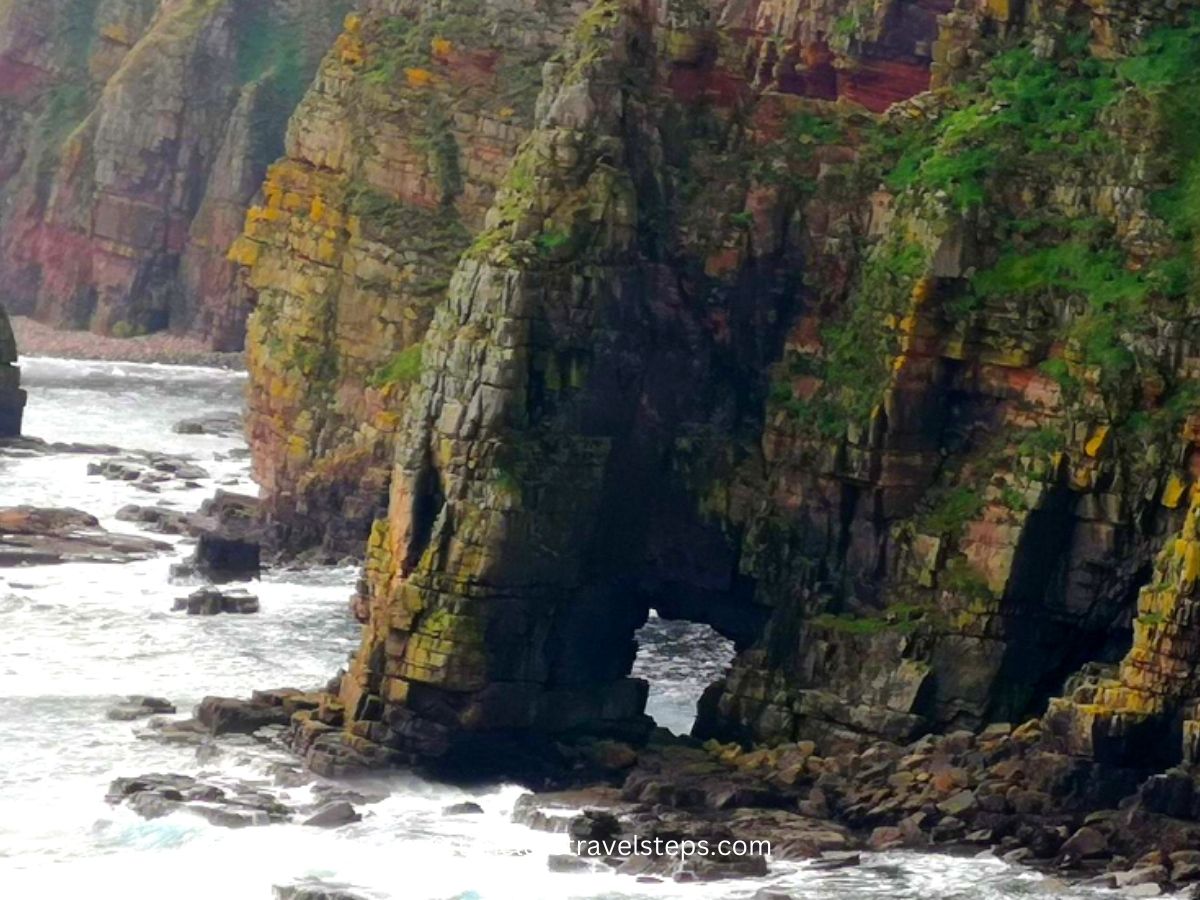
Why Are the Duncansby Sea Stacks Famous?
Geological formations aside, the Duncansby Sea Stacks are famous for their dramatic appearance and the stunning coastal scenery they provide against the backdrop of the North Sea, representing a cherished symbol of Scotland’s natural heritage.
From the cliff-top coastal path, they present an awe-inspiring sight, rising gallantly from the sea waters. This area is also a haven for a variety of seabirds, contributing significantly to the region’s ecological diversity.
Their dramatic appearance, coupled with the rich wildlife and panoramic views, make the Duncansby Sea Stacks, among the most photographed natural landmarks in Scotland, drawing visitors and photographers from around the globe.
The Duncansby Stacks Walk is a must-visit destination, best experienced at an unhurried pace. It offers an opportunity to immerse yourself in the unspoilt beauty of the Scottish Highlands and provides a unique perspective of Scotland’s northern shores. For any travel enthusiast exploring the mystical Highlands, this walk is undoubtedly a highlight.
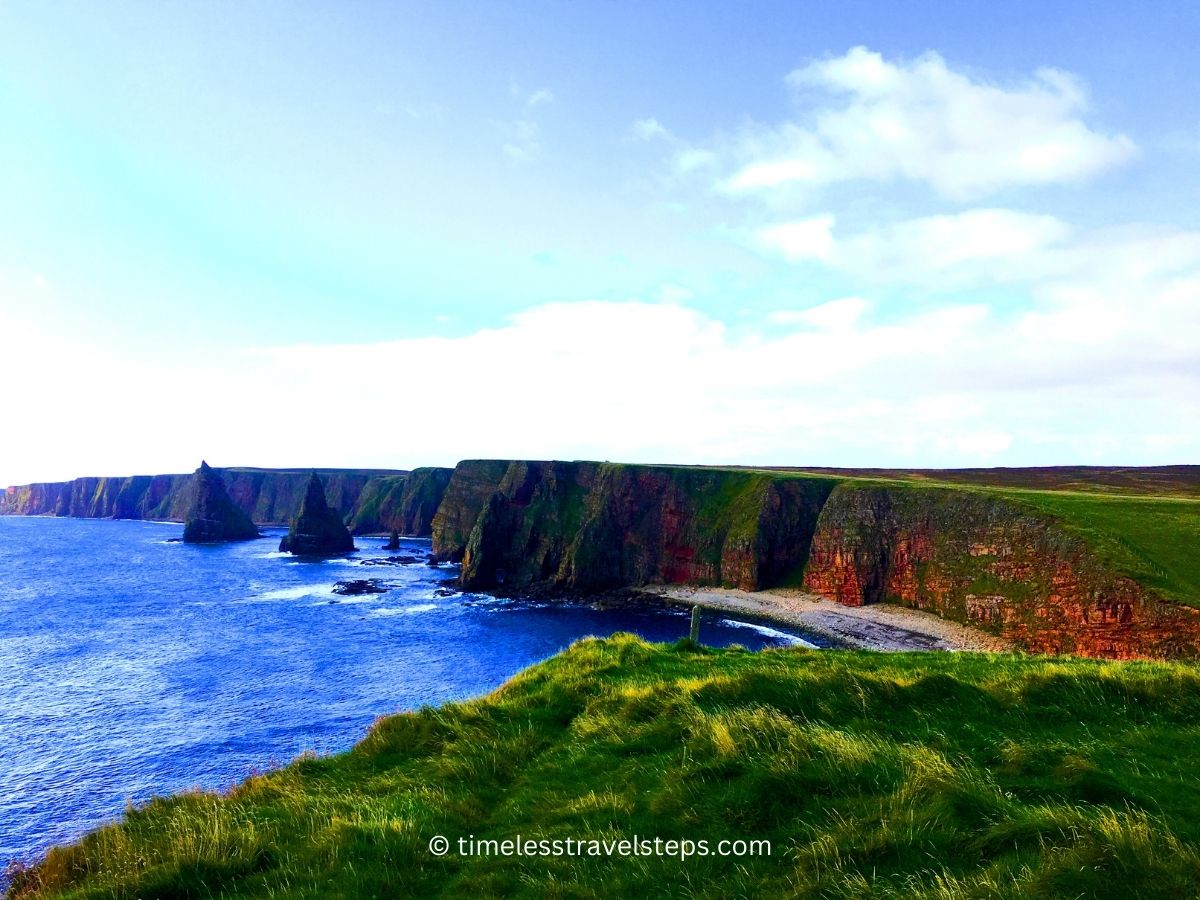
When is the Best Time to Go on Duncansby Stacks Walk?
The best time to undertake the Duncansby Stacks Walk is typically during the spring and summer months, from late April to early September. During this period, the weather is generally more favourable, with milder temperatures and longer daylight hours, enhancing the walking experience. This time of year also coincides with the breeding season for seabirds, including puffins, which can be a highlight for wildlife enthusiasts. However, it’s always a good idea to check the local weather forecast before your visit, as conditions can be unpredictable in the Scottish Highlands.
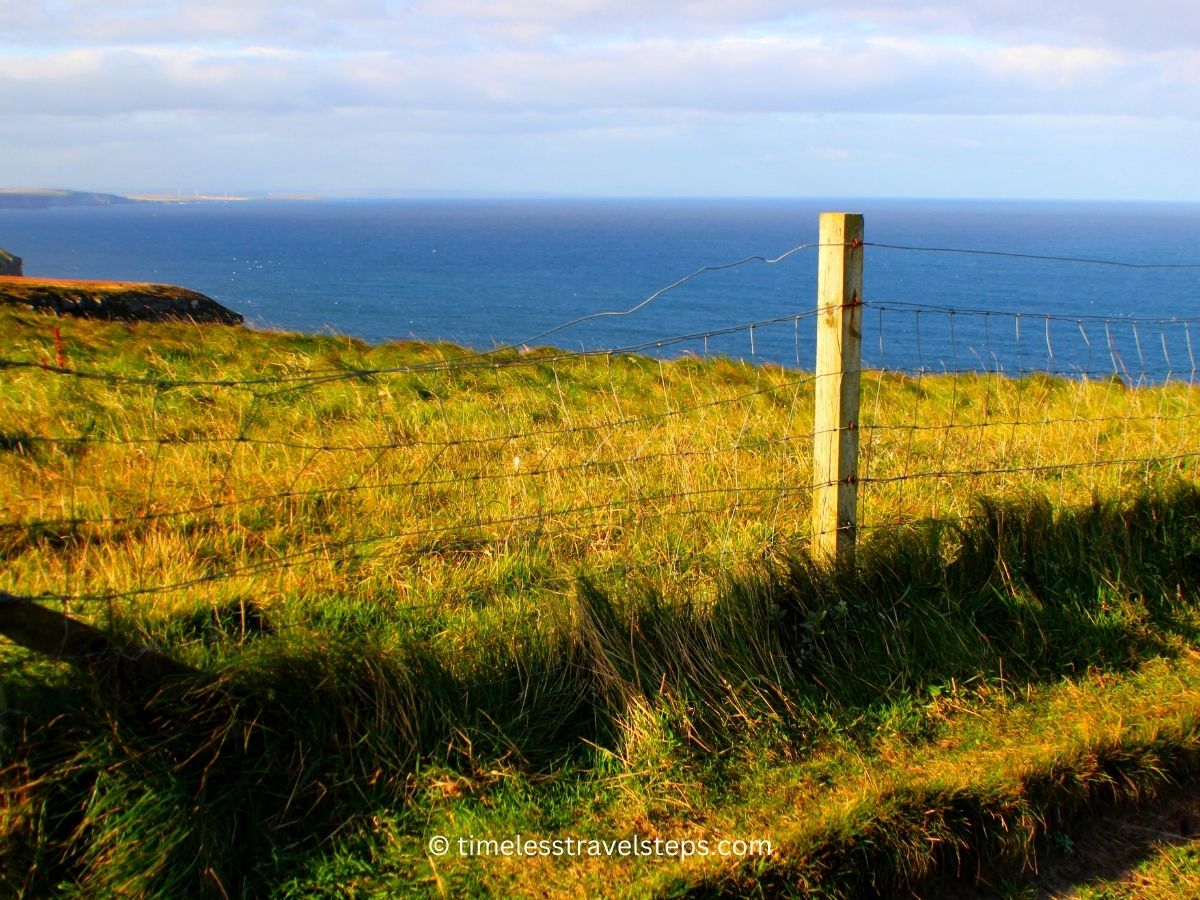
Why Choose a Self-Guided Walk of Duncansby Stacks?
When it comes to ‘why choose a self-guided walk’ – the reason is simple. You don’t need a guide! The path is well-trodden and clearly sign-posted. A simple yet safe fencing runs along the cliff’s edge, clearly marking the direction for the best views of the sea stacks.
Additionally, exploring independently means you’re free from the constraints of time that come with organized tours. My first visit was with a tour group, and I felt that we were not given enough time to fully appreciate this walk, along with its surroundings. We had to rush through a speedy walk, snap a few photos and return to the car park.
Navigating the challenges of taking photos while battling the winds certainly adds to the adventure. You may need time to adjust your camera settings to avoid blurry images. However, the effort is worthwhile, as the resulting pictures capture the stunning beauty of the landscape in a way that’s truly rewarding.
Navigating the Duncansby Stacks Walk is an opportunity to fully engage with the wildlife, absorb the rugged beauty of the Caithness coastline, and take the time to capture photographs without rushing.
 100vw, 600px” data-recalc-dims=”1″><figcaption class=) sea stacks at Duncansby
sea stacks at Duncansby 100vw, 600px” data-recalc-dims=”1″><figcaption class=) Duncansby Head shoreline
Duncansby Head shorelineWhere is Duncansby Sea Stacks in Scotland?
The Stacks of Duncansby are easy to get to. Your journey begins with a scenic drive to the quaint village of John o’ Groats in Caithness. While John o’ Groats is a renowned landmark in itself, the actual starting point of the breathtaking Duncansby Stacks Walk is a bit further, near the Duncansby Head Lighthouse, across the Duncansby Headland.
To begin your Duncansby Stacks Walk, head to the Duncansby Head Lighthouse at GPS Coordinates: 58.6430° N, 3.0250° W, where you can easily find parking spaces. This parking area serves as the ideal commencement spot for the scenic Duncansby Stacks Walk which is just 500 meters away.
Accessibility to the Duncansby Stacks is straightforward from major Scottish towns.
- From Inverness, it’s about a 2.5 to 3-hour drive, covering approximately 193 kilometers (120 miles) via the A9 and A99.
- From Edinburgh and Glasgow, the drive takes around 5 to 6.5 hours, spanning 439 to 451 kilometers (273 to 280 miles), mostly along the A9.
- Aberdeen offers a shorter drive of about 278 kilometers (173 miles) 3.5 to 4 hours via the A96 and A9.
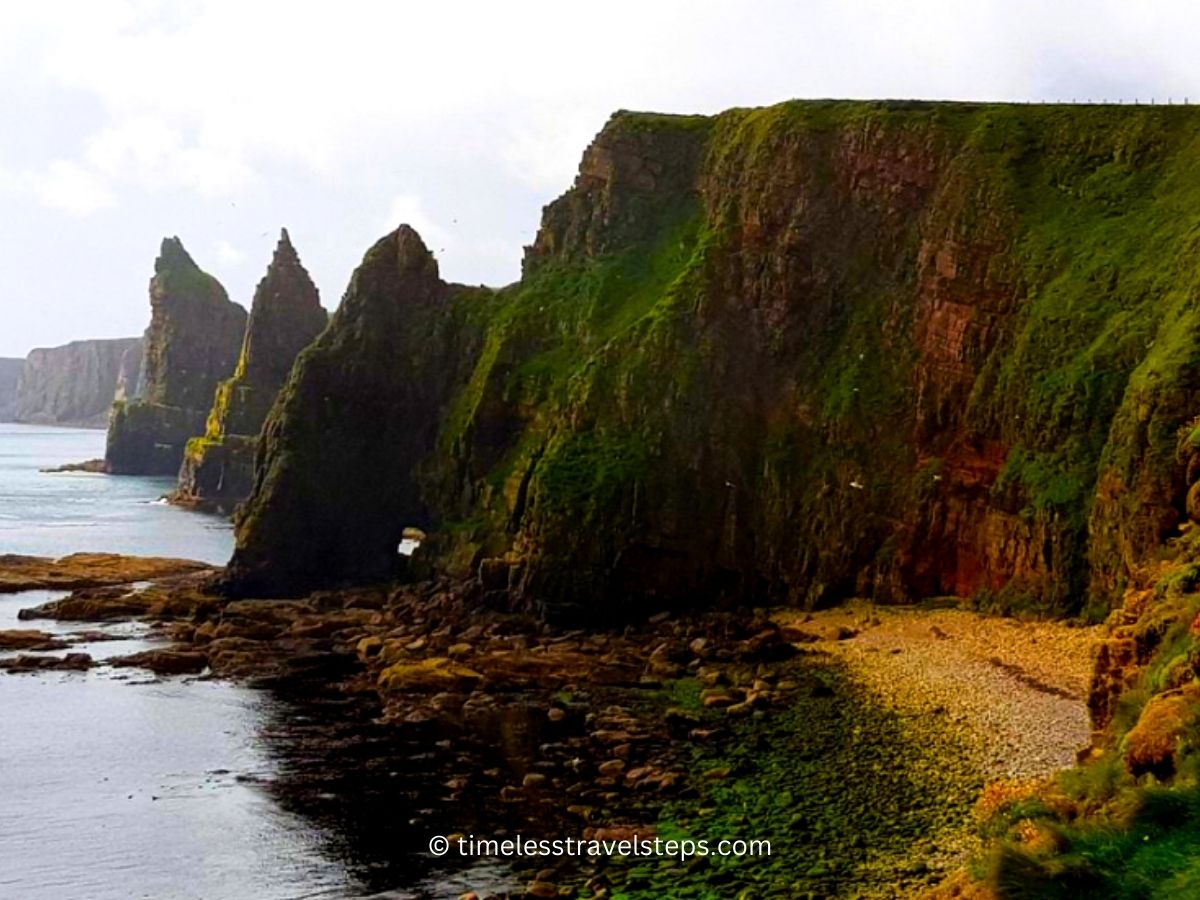
Practical Tips for the Duncansby Stacks Walk
Preparing for your adventure through the Scottish Highlands is key to ensuring a memorable and enjoyable experience. Here are some essential tips for the Duncansby Stacks Walk:
Appropriate Clothing: Given Scotland’s unpredictable weather, dressing in layers is wise. It allows you to adjust to changing conditions. Use a hooded windbreaker and a beanie for the off-seasons.
Walking Shoes: Ensure you wear sturdy walking shoes for comfort and safety on the uneven terrain. Waterproof is a better option for rainy days.
Water and Snacks: With limited amenities near the stacks, carrying enough water and snacks to keep you hydrated and energized is crucial. This is especially important if you plan to spend a considerable amount of time exploring and photographing the area.
Camera: The breathtaking views of the sea stacks and rugged coastline are a photographer’s dream. Bring your camera along with a sturdy tripod to capture these stunning landscapes.
Environmental Awareness: The beauty of the Duncansby Stacks and its surroundings is pristine. Help keep it that way by adhering to Leave No Trace principles. This means taking all your rubbish with you, staying on designated paths, and respecting the local flora and fauna.
The walk to the Duncansby Stacks from the Duncansby Head Lighthouse car park is a beautiful coastal walk on grassy terrain. It’s a manageable cliff-top walk of roughly 1.2 kilometers one-way, (round-trip is approximately 2.5 kilometers) making it suitable for walkers of all levels. Depending on your walking pace and how often you stop to enjoy the views, it usually takes about 20 to 30 minutes to reach the stacks. This estimate can vary based on individual walking speeds and how much time is spent taking photographs or observing wildlife along the way.
While it is an open grassland, there are some interesting spots that affords excellent views over the coast.
Step onto the grassy expanse of Duncansby Headland, about 500-meter south of the lighthouse. A signpost thoughtfully placed marks the beginning of your path towards the Duncansby Stacks. As you leave the lighthouse behind, follow the path that gracefully winds along the cliff edge of the headland. The vast North Sea, to your left, offers a constant, serene presence.
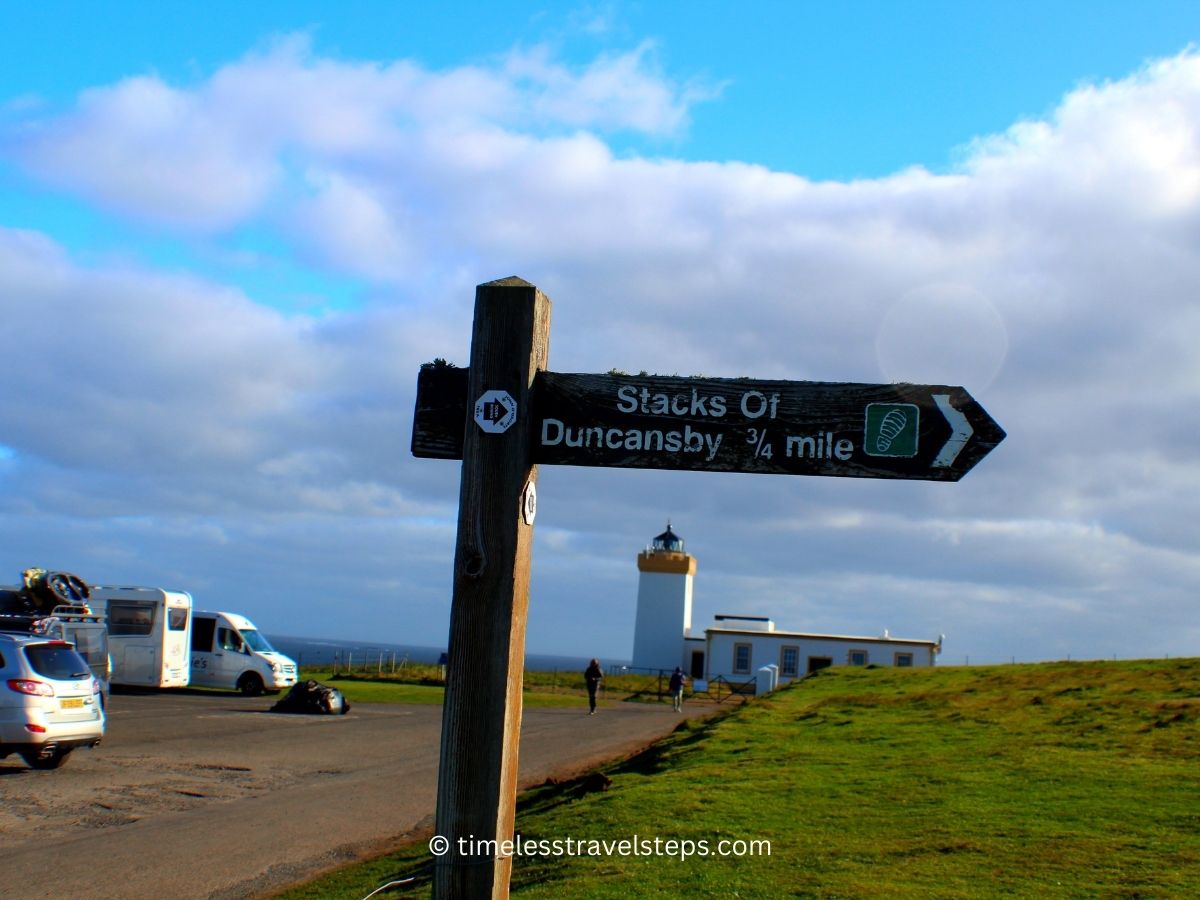
Sturdy footwear is advised for the uneven terrain typical of this rugged headland.
Along your coastal walk, you’ll notice some key landmarks and navigational points. Here are a few I made a note of:
Ordnance Survey Trig Point
Soon along your walk, you’ll notice a small concrete block. This is an Ordnance Survey trig point, used for mapping and surveying the land. It’s a subtle yet significant marker on your journey.
As you continue, the path, marked by well-trodden areas in the grass, weaves through a pastoral scene where you might see grazing sheep.
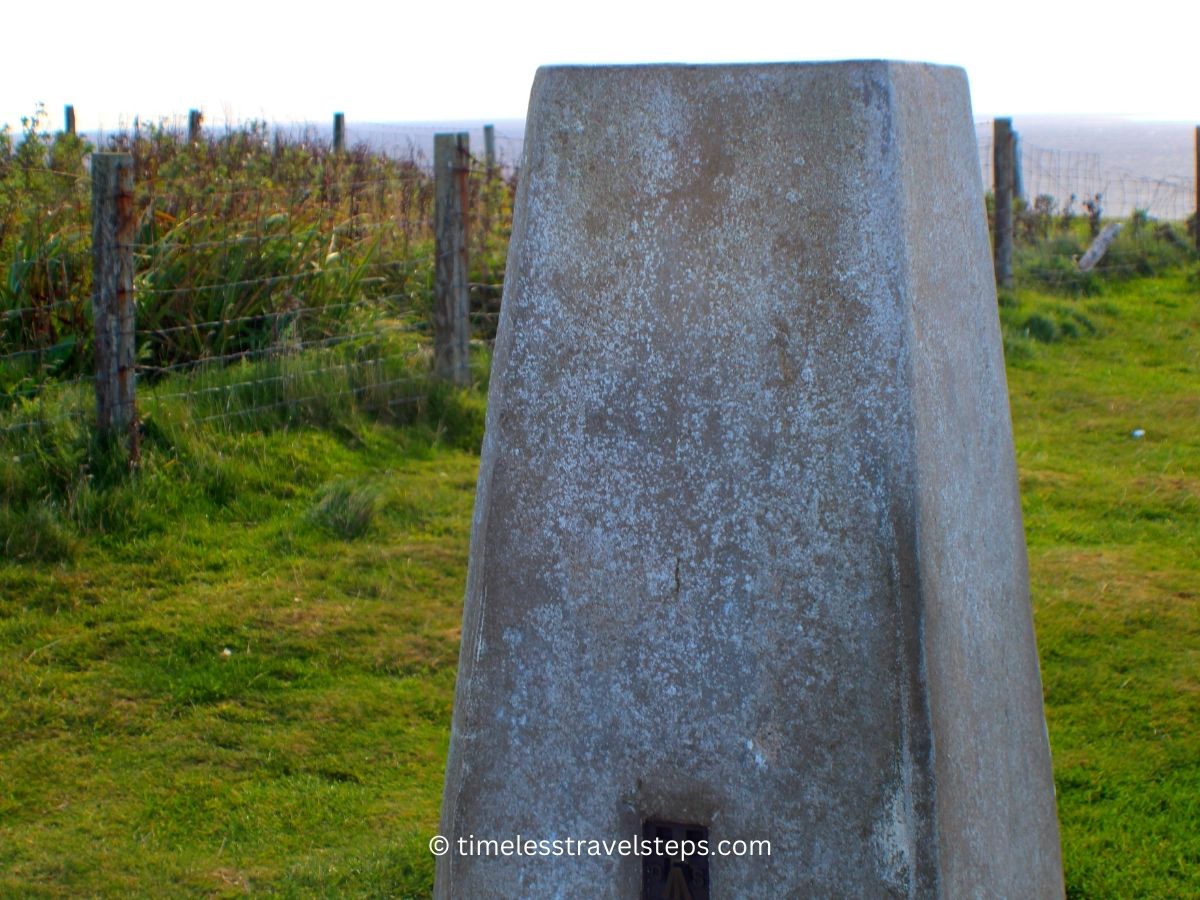
The Geo of Sclaites
Your next major stop is the Geo of Sclaites, an impressive cleft carved by the sea. This natural wonder is not only a visual highlight but also a popular spot for seabirds. Spend some time here, walking around the edge, to fully appreciate its splendour and perhaps catch sight of the local avian inhabitants.
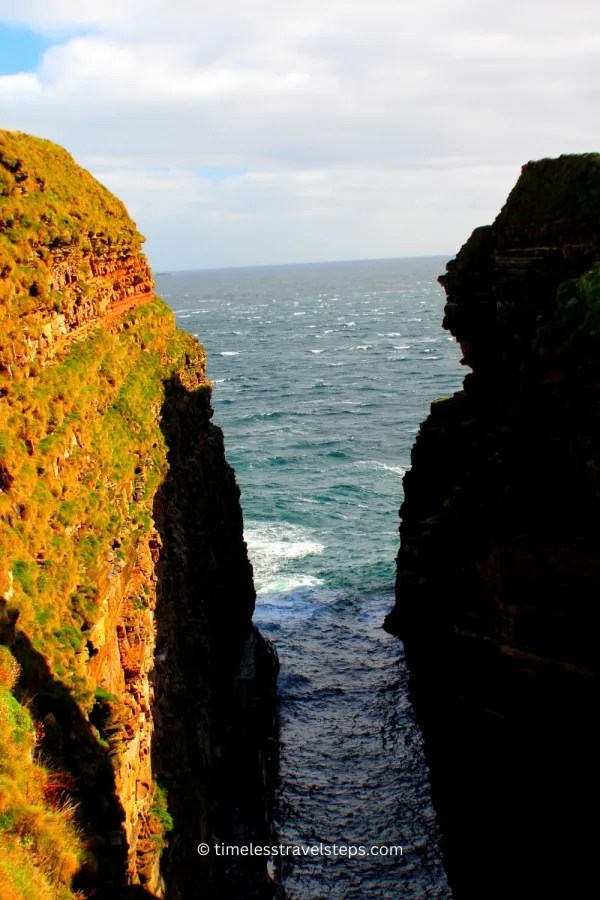
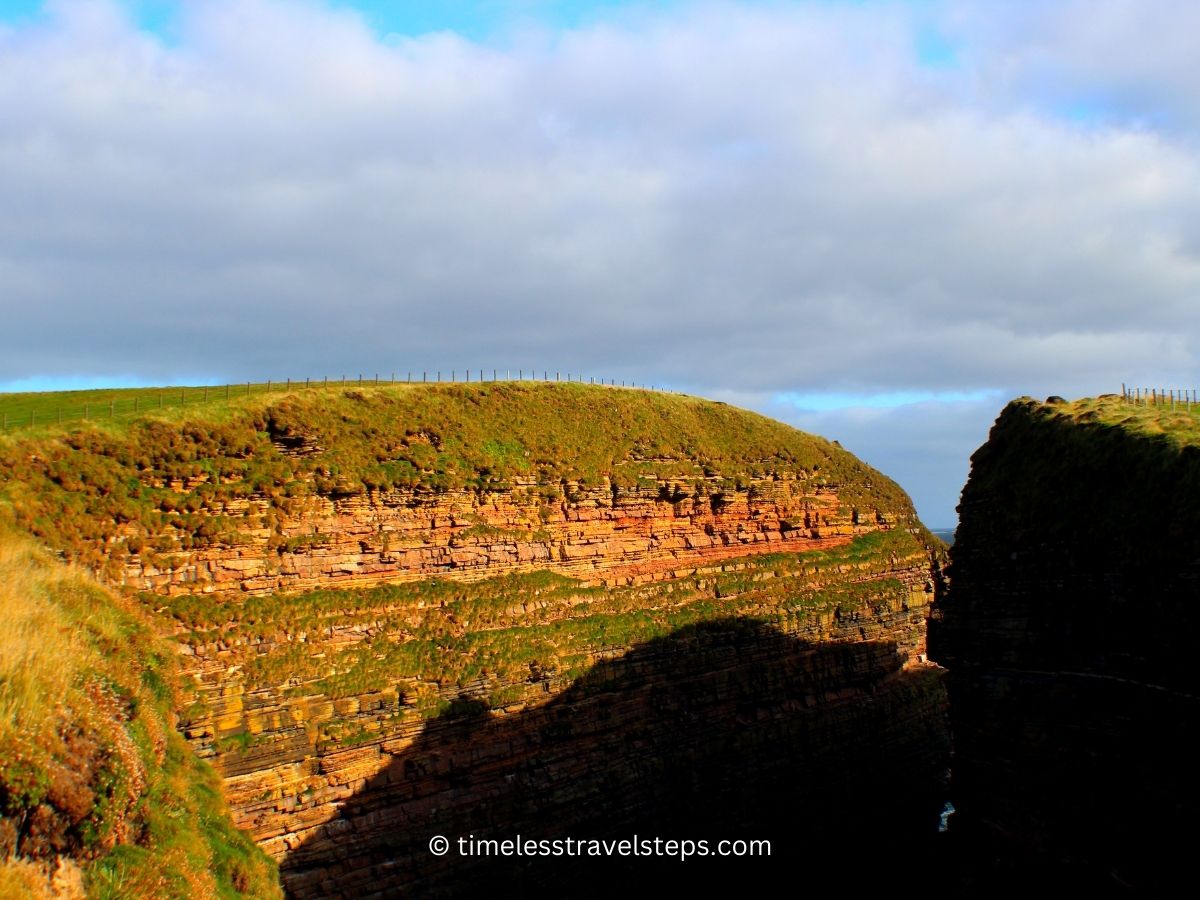
Throughout your walk, keep in mind that the uneven ground and proximity to the cliff edge require a degree of caution. This walk is as much about enjoying the journey as it is about reaching the destination. The rugged terrain, the presence of wildlife, and the breathtaking views all combine to make the Duncansby Stacks Walk a memorable experience in the Scottish Highlands.
From the Geo of Sclaites to the main Duncansby Stacks
After spending time at the Geo of Sclaites, your next move is to walk towards the sea. On your way, you’ll encounter a small stack, standing a short distance from the cliffs. The path to this stack is less trodden, a bit of an off-beaten track, but venturing this way is rewarding. It offers a different perspective and a sense of discovery as you explore slightly beyond the usual path.
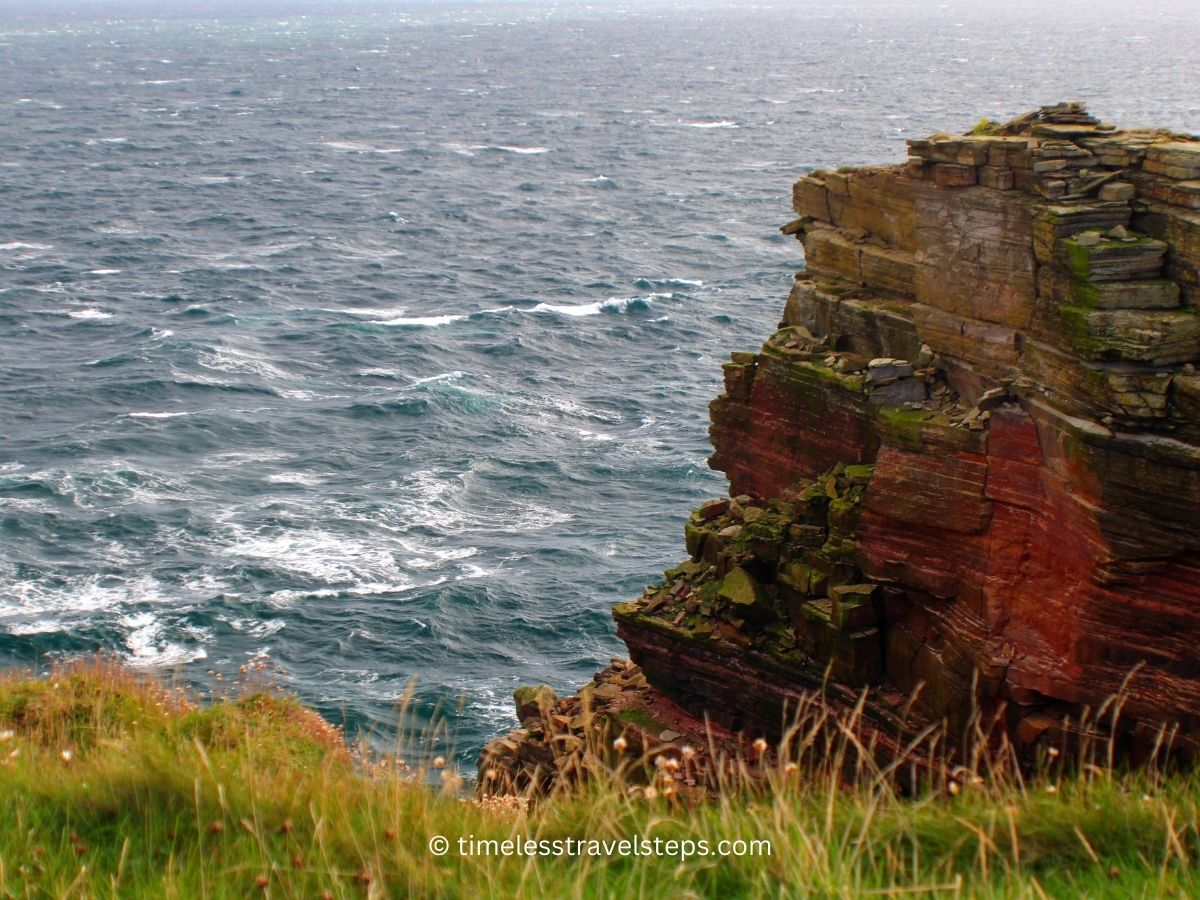
First Glimpse of the Main Duncansby Stacks
As you navigate this picturesque path, the brisk, lively wind is a constant companion, adding a refreshing element to the experience. It’s strong enough to make you want to hold onto your beanie tightly! With seabirds gliding overhead, sheep dotting the nearby fields, and the wind carrying the scent of the sea, encapsulates the essence of the unspoilt Highlands.
A thrilling moment awaits. Soon, the tips of the main Duncansby Stacks begin to emerge on the horizon, peeking through the headland. The vivid blue of the sea contrasts beautifully with the rugged stacks, creating a stunning visual tapestry. This first glimpse is nothing short of awe-inspiring.
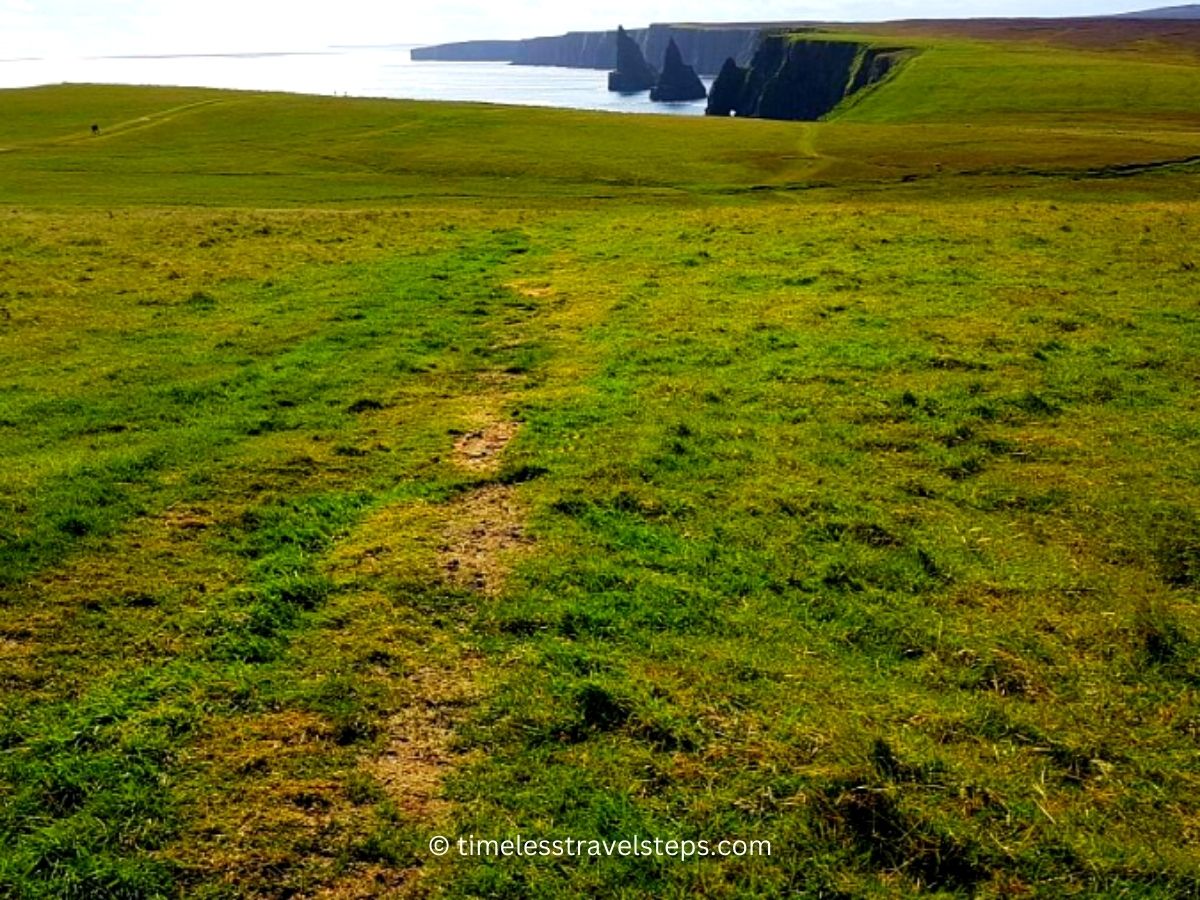
Approaching the Stacks
As you near the stacks, the view becomes increasingly spectacular. The sight of the Duncansby Stacks standing together against the backdrop of the ocean is a highlight of the walk. It’s a fantastic spot to pause and take in the view, capturing the moment with photos or simply enjoying the serene beauty of the landscape.
This section of the Duncansby Stacks Walk is where the true magnificence of the Highlands unfolds, offering a memorable experience that is emblematic of Scotland’s natural grandeur.
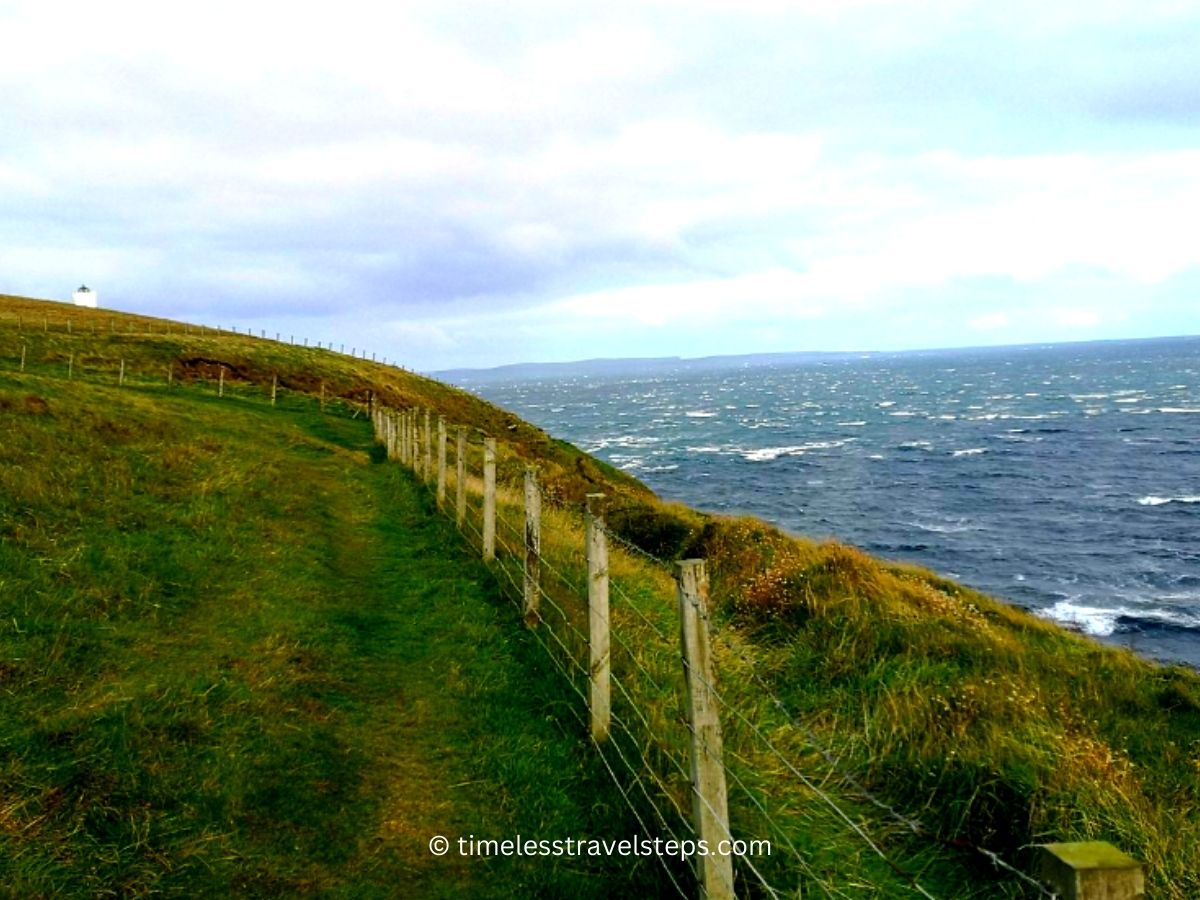
Continuing your journey around the cliff edge to view the Duncansby Stacks
As you venture further, the well-trodden grass path becomes more distinct underfoot, weaving its way through the stunning landscape.
Follow along the fence line, which acts as a gentle guide through this rugged terrain. The path, at one particular stretch, brings you tantalizingly close to the cliff edge. It’s here that you are treated to a magnificent panoramic view, a sight that will surely take your breath away.
The majestic Duncansby Stacks rise gallantly from the sea, their formidable presence a testament to the power and beauty of nature. The view from this vantage point is unrivaled, with the stacks framed perfectly against the vast expanse of the ocean. The sea’s deep blue hues contrast with the vibrant green of the grassy cliffs, creating a visual spectacle that captivates the soul.
Take a moment to absorb the grandeur of the scene. Spend some time here taking photographs from various angles. This is a place where the wild spirit of Scotland is not just seen but felt, making your walk around the cliff edge an experience of profound beauty and awe.


Concluding your Duncansby Stacks Walk
The return to the car park is simply a matter of retracing your steps. Follow the same grassy path back, or you may want to walk across the field to shorten your walk. Whatever you opt to do, keep an eye out for any wildlife or natural scenes you may not have fully appreciated before.
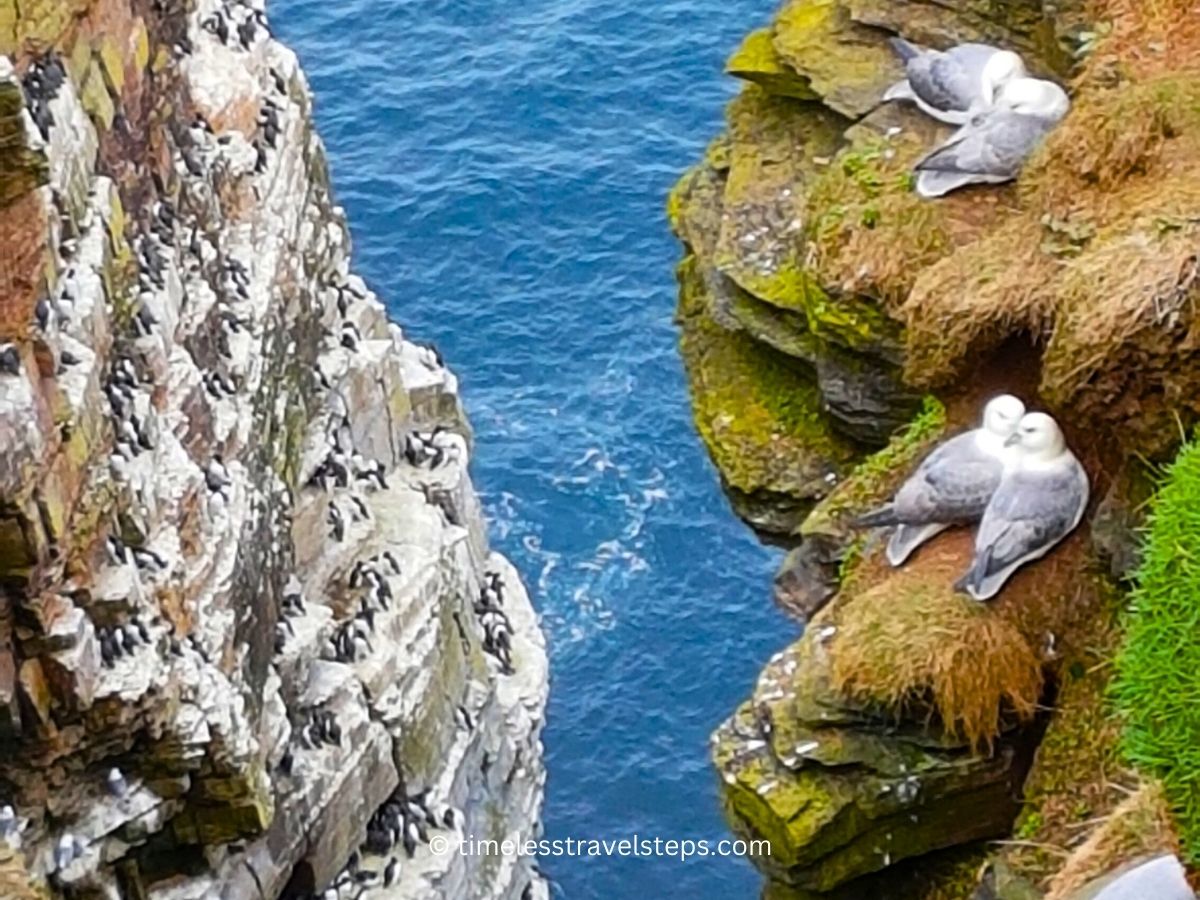
Additional Practical Considerations
Amenities: Facilities in the area are sparse, so plan accordingly. Make sure to use the restroom before starting the walk, and bring any necessary supplies.
Weather Check: Always check the weather forecast before heading out. The conditions can change rapidly, and being prepared for rain or wind will make your walk more comfortable.
Picnic Spots: While there are no designated picnic areas, you’ll find dedicated benches dotted around the landscape. These spots are perfect for a mini picnic, offering a chance to take a break and enjoy the views. They’re ideal for soaking in the scenery and perhaps capturing a few more photographs.
Safety: Stay away from cliff edges, as they can be unstable. Keep an eye on the weather and be prepared to turn back if conditions worsen.
By following these practical tips, you’ll be well-prepared to enjoy the Duncansby Stacks Walk safely and responsibly.
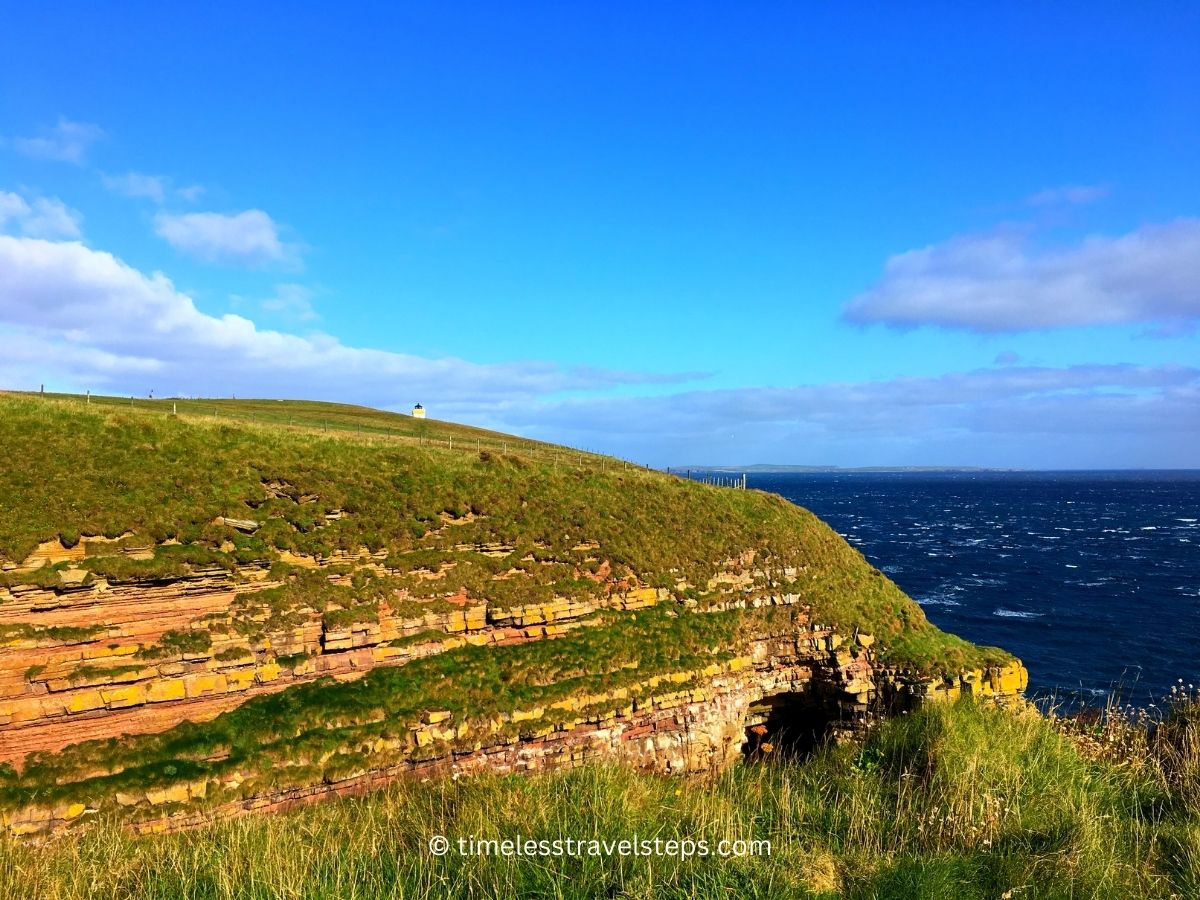
What to Do After the Duncansby Stacks Walk
After completing your Duncansby Stacks Walk, the adventure doesn’t have to end there. The surrounding area offers delightful activities and spots that are perfect for families and photography enthusiasts alike.
Exploring Nearby Attractions
Dunnet Head Lighthouse – A Photogenic Spot: Although not open to the public, its unique design and the hollowed position it occupies on the cliff make it an excellent subject for photographers. The area around the lighthouse is ideal for families. Its open spaces and scenic surroundings provide a perfect backdrop for memorable photos and a chance for children to explore safely.
John o’ Groats: This iconic village is well worth a visit. It’s famous for being one end of the longest distance between two inhabited points on the British mainland, with the other end being Land’s End in England.
Castle of Mey: A little further afield, but definitely worth the drive, is the Castle of Mey. This historic castle was a favourite of the late Queen Mother and is open to the public during the summer months.
Dunnet Head: Take a photo of you at the northernmost point of the British mainland, offering breathtaking views and a different perspective of the coastline.

Local Eateries and Cafes
Stacks Coffee House & Bistro: Located in John o’ Groats, this cozy spot is ideal for a relaxing coffee break, serving up homemade cakes and light bites.
The Northern Sands Hotel: Near Dunnet Head, this hotel offers a more substantial dining experience, with a menu that showcases the best of local produce.
There’s plenty to do after your walk to the Duncansby Stacks, so don’t rush back 🙂
FAQs About Duncansby Stacks Walk
The walk from the Duncansby Head Lighthouse car park to the stacks is about 3 kilometers round trip. It typically takes around 45 minutes to an hour to complete, depending on your pace and how long you spend enjoying the views.
To view the Duncansby Stacks, start at the Duncansby Head Lighthouse car park. From there, it’s a short walk along the coast. The path leads you to various viewpoints offering spectacular views of the stacks.
Yes, puffins can be seen at Duncansby Head, particularly during their breeding season, which is typically from late spring to early summer. This period is ideal for birdwatchers, as the puffins are more active and visible along the cliffs.
Overnight parking at Duncansby Head is generally not permitted.
The ideal time to visit is during the spring and summer for more favourable weather and wildlife viewing opportunities. During this time, the landscape is at its most vibrant, and the days are longer, offering more time to explore.
The walk is generally family-friendly, but caution is advised near cliff edges to ensure safety. It’s a great opportunity for children to experience nature, but supervision is key.
Facilities near the stacks are quite limited. The nearest amenities, including restrooms and cafes, can be found in John o’ Groats. Plan to visit these facilities before or after your walk.
While no special equipment is needed, sturdy walking shoes and clothing suitable for changeable weather are recommended. Being prepared for varied conditions will enhance your comfort and enjoyment of the walk.
Dogs are usually allowed on the walk but should be kept on a leash at all times for their safety and the protection of local wildlife.
There is no parking fee at the Duncansby Head Lighthouse car park.
The natural terrain of the walk might be challenging for individuals with mobility issues. The path is uneven in places and may not be suitable for wheelchairs or walkers.
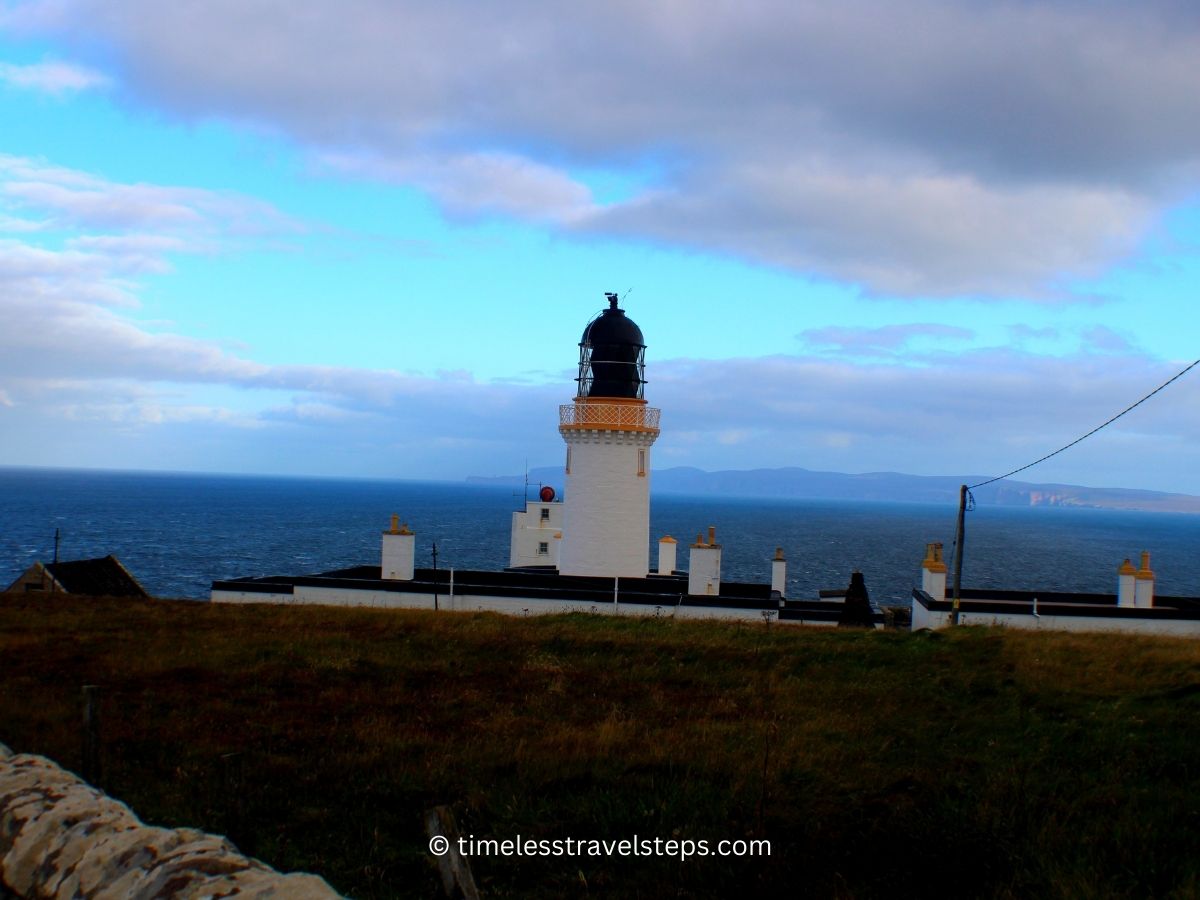
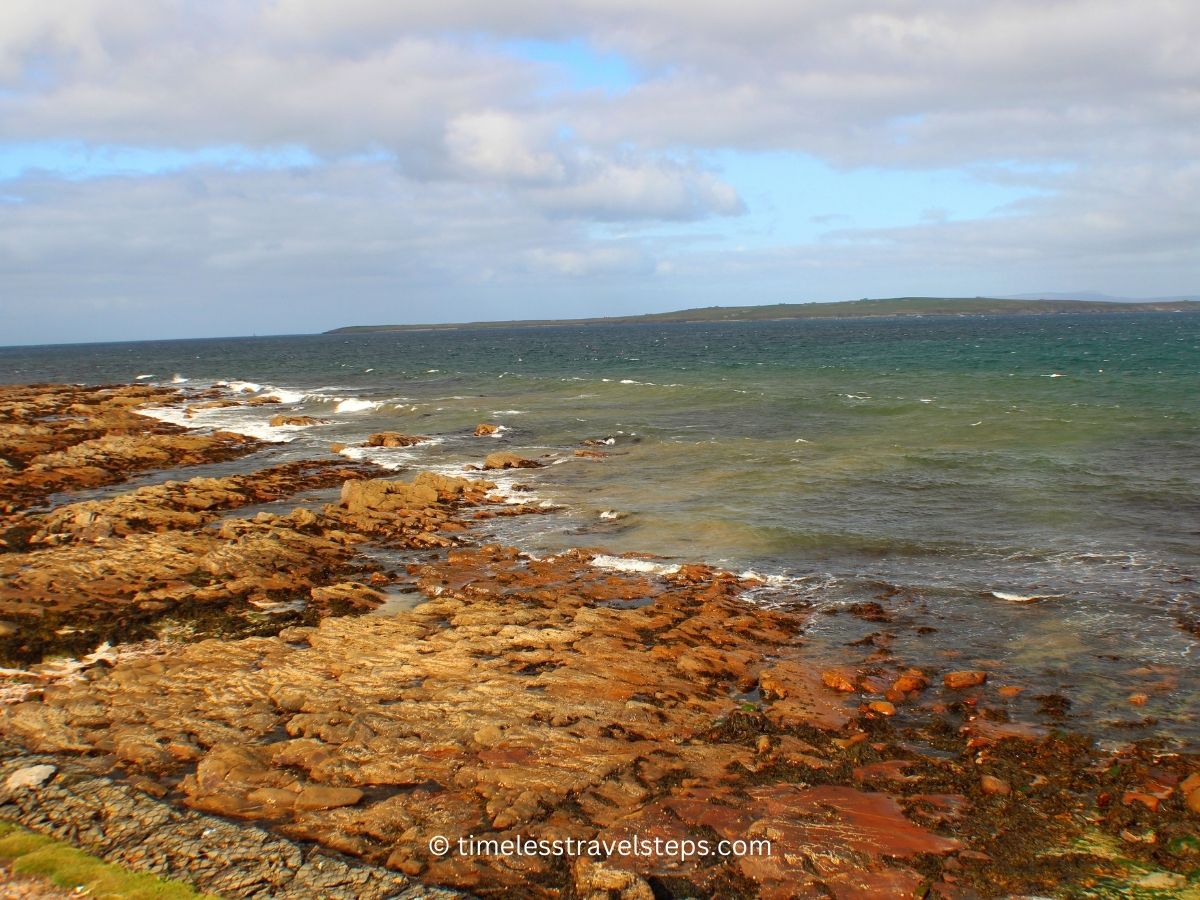
in essence…
Embracing the Duncansby Stacks Walk without a tour allows you to truly immerse yourself in the serene beauty of the Scottish Highlands at your own pace. This self-guided journey is not just a path through scenic landscapes but an invitation to connect deeply with nature. The freedom to explore without the constraints of a tour means you have the time to appreciate the towering sea stacks, observe the vibrant wildlife, and absorb the breathtaking views without rush.
A solo adventure here lets you experience the raw, unfiltered essence of the Highlands, offering moments of tranquility and reflection that are often lost in structured group tours. This walk is a celebration of nature’s wonders, best enjoyed unhurriedly, leaving you with a profound appreciation for Scotland’s natural heritage and memories that linger long after the journey ends.
However, if you prefer a small group tour, go for these companies that include a visit to John O’Groats and Duncansby Head:
A Day Trip From Inverness to the Far North and John O’Groats.
Multi-Day Tour of Orkney and the Northern Coast.
Happy and Safe Travels Always, Wherever Travel Takes You, xx
Explore the Scottish Highland
Having experienced the awe-inspiring Duncansby Stacks, your journey through the Scottish Highlands is just beginning. Embark on scenic drives that weave through the heart of Scotland’s stunning landscapes, taking you past dramatic coastlines, serene lochs, and majestic mountains. Here are some articles to pique your interests about Scotland and the NC500 Route:



